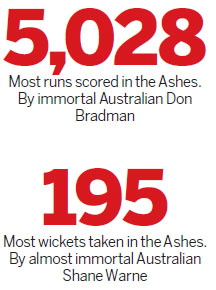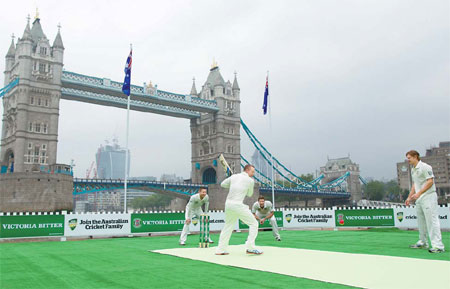A journey from ashes to ashes
Updated: 2013-07-09 06:14
By Tym Glaser (China Daily)
|
|||||||||||
|
Australia's Michael Clarke (left), Chris Rogers (second left), James Faulkner (second right) and Shane Watson (right) play a game of cricket on a barge in the Thames by the Tower Bridge in central London on June 20. Andrew Cowie / Agence France-Presse |

It's simply not just cricket when traditional rivals Australia and England face each other in a Test series, writes Tym Glaser.
Nothing stiffens the sinews and conjures up the blood for Englishmen and Australians like an Ashes series. The great rivals first clashed on a cricket field - on equal terms - way back in Melbourne in 1877. The beginning of the most enduring, on-going rivalry between two countries.
The host won that first clash by 45 runs in an event which some Aussies believe was the start of the island continent slowly disentangling itself from the apron strings of the "mother country".
Federation in 1901 and the tragically gallant Gallipoli campaign during World War I were more famous events as Australia became more than an appendage of the British Empire, but on that paddock in Melbourne, basically the site of today's grand Melbourne Cricket Ground, a budding nation not far removed from its convict past showed it could produce more than wool and other raw products and be more than a mere offshoot of England.
Wednesday, at Trent Bridge in Nottingham, England and Australia will play their 311th Test and 67th series (for the uninitiated, a series usually comprises five Tests).
The men in the baggy green caps hold an ever-so-slight edge in series won (31 to 30 with five drawn) and, overall, boast 123 Test wins. England has an even 100 victories and there have been 87 (a traditionally unlucky Australian cricket number being 13 short of 100) draws.
The "ashes" came into being in 1882 when Australia won its first "test" in England and a notice appeared in The Sporting Times announcing:
In Affectionate Remembrance of
ENGLISH CRICKET,
which died at the Oval on 29th AUGUST 1882,
Deeply lamented by a large circle of sorrowing
friends and acquaintances
R.I.P.
N.B.-The body will be cremated and the
ashes taken to Australia.
When England captain Ivo Bligh and his side won the subsequent series in Australia in 1882-83 he was presented with an urn containing ashes (which some believe are a burnt bail, but most likely newspaper).
The now fragile, terra-cotta urn is all of 11 centimeters in height, making it arguably the least impressive trophy in the whole wide world of sport.
However, it's not the size of the prize, it's the magic it can conjure.
The greatness of Australian and England cricketers is not measured by base statistics and World Cups won; it's all about what they did in the Ashes.
The infamous Bodyline series of 1932-33, when England bowlers deliberately tried to hit the Australian batsmen to curb the brilliance of Don Bradman; the Australian Invincibles of 1948, who went through an entire tour of England undefeated; Botham's Ashes of 1981, when skipper Ian Botham was sacked as captain but came back to almost singlehandedly win the series and, to Englishmen at least, the 2005 home series which they regard as the greatest ever played when the host finally broke a 16-year drought with a thrilling 2-1 victory, have been written boldly into cricket lore along with all their protagonists.
And that's what Michael Clarke's Aussies and Alastair Cook's Poms will be chasing over the next seven months as the teams battle through an unprecedented 10 Tests in a row - five in the UK and five Down Under.
The sides should be thoroughly sick of the sight of each other by the time the last ball is bowled in the fifth Test in Sydney in January.
But holding a replica of that eensy-weensy urn should more than ease any nausea as another chapter in one of sport's greatest rivalries is written.
Tym Glaser is a senior sports copy editor who saw his first Ashes Test at the Adelaide Oval during the 1974-75 series. He can be contacted at tymglaser@chinadaily.com.cn
(China Daily 07/09/2013 page22)
Today's Top News
China's inflation grows 2.7% in June
US mulls hastening withdrawal from Afghanistan
Laden's life on the run revealed
Air crash victims'parents leave for US
Premier Li lauds Guangxi's potential
Mining firm confirmed to have polluted S China river
Legislation urged to guarantee nuclear security
Ex-rail chief sentenced
Hot Topics
Lunar probe , China growth forecasts, Emission rules get tougher, China seen through 'colored lens', International board,
Editor's Picks

|

|

|

|

|

|






